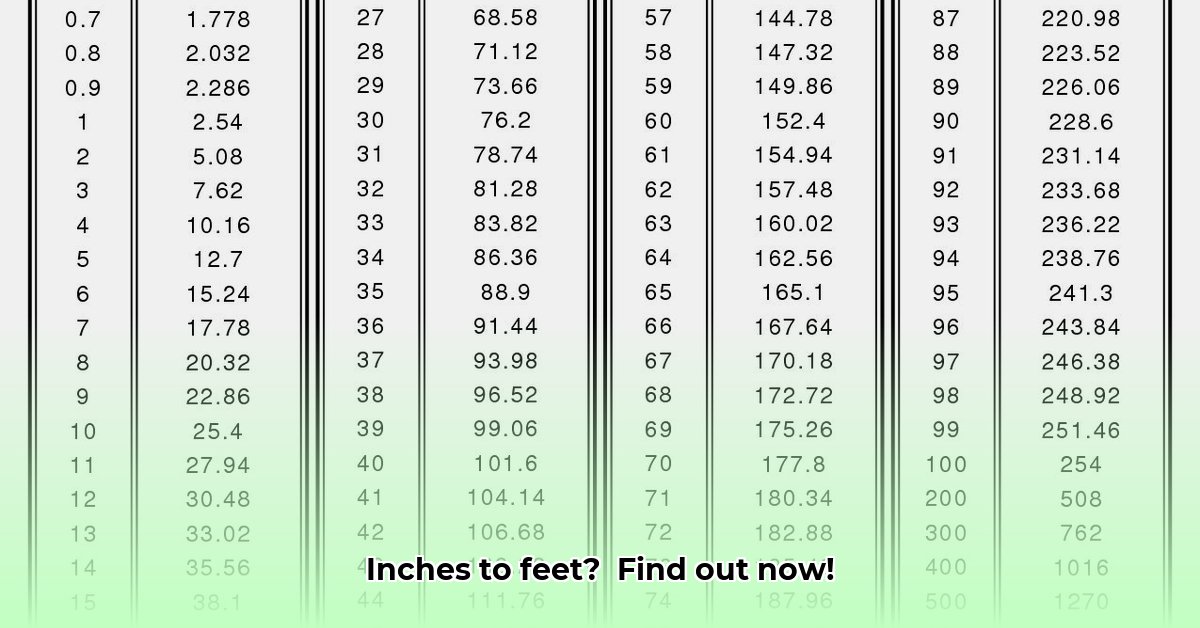Have you ever needed to convert 170 inches into feet? Whether you’re tackling a DIY home improvement project, figuring out if that new bookshelf will fit perfectly, or simply satisfying your curiosity, understanding how to convert between these units of measurement is a valuable skill. For other unit conversions, check out this useful resource: Unit Converter. This detailed guide provides a clear, step-by-step explanation of the conversion process, explores different ways to express the result, and highlights the importance of accuracy in various real-world applications.
Understanding Inches and Feet
Before diving into the conversion, let’s clarify what inches and feet represent:
- Inch (in): An inch is a unit of length in the imperial and U.S. customary systems of measurement. It’s defined as 1/12 of a foot.
- Foot (ft): A foot is another unit of length in these systems, equal to 12 inches. It’s commonly used to measure height, length, and short distances.
The Conversion Factor: Your Key to Success
The fundamental principle behind converting inches to feet lies in the relationship between the two units. Since there are 12 inches in every foot, the conversion factor is 1/12 or approximately 0.08333. This means that to convert inches to feet, you divide the number of inches by 12.
Step-by-Step Guide: Converting 170 Inches to Feet
Let’s apply this principle to convert 170 inches into feet:
Step 1: Set up the Conversion
Write down the value you want to convert (170 inches) and the conversion factor (1 foot / 12 inches):
170 inches * (1 foot / 12 inches)
Step 2: Perform the Calculation
Divide 170 inches by 12 inches/foot:
170 inches ÷ 12 inches/foot = 14.166666… feet
Step 3: Expressing the Result in Different Forms
The result, 14.166666… feet, is a repeating decimal. While accurate, it’s not always the most practical way to express the measurement. Here’s how you can represent the answer in different formats:
Decimal Form
This is the simplest way to express the result. You can round the decimal to a suitable level of precision, depending on your needs. For most applications, rounding to two decimal places is sufficient:
- 17 feet (rounded to two decimal places)
Fractional Form
To express the result as a fraction, identify the repeating decimal portion. In this case, .166666… is equivalent to 1/6. Therefore, the fractional representation is:
14 1/6 feet
This is the most accurate representation, as it avoids rounding errors altogether.
Feet and Inches Form
This format is often the most intuitive for visualizing and communicating measurements, especially in construction and home improvement projects. To convert the decimal portion of the result to inches, multiply it by 12:
- 166666… feet * 12 inches/foot ≈ 2 inches
Therefore, 170 inches is equal to:
14 feet 2 inches
Verifying Your Results: Online Conversion Tools
Numerous online converters can quickly convert inches to feet. Here are a few examples and the results they provide:
| Converter Website | Result |
|---|---|
| Google Search | 14.1666667 feet |
| Inch Calculator (inchcalculator.com) | 14.17 feet (approx.) |
| Calculate Me (calculateme.com) | 14.2 feet (approx.) |
As you can see, the results are consistent across different platforms. However, slight variations may occur due to rounding differences. Always double-check the results, especially when precision is crucial.
Real-World Applications: Why Accurate Conversions Matter
Accurate inch-to-foot conversions are essential in a variety of fields:
- Construction: From framing walls to installing flooring, precise measurements are critical for ensuring structural integrity and aesthetic appeal.
- Interior Design: Determining furniture placement, curtain lengths, and rug sizes all rely on accurate conversions.
- Manufacturing: Machining parts, assembling products, and ensuring dimensional accuracy require precise measurements in both inches and feet.
- DIY & Home Improvement: Hanging shelves, building furniture, or laying tile require accurate measurements to ensure a professional-looking result.
Tips for Accurate Conversions
- Use a Calculator: A calculator can simplify the division process and minimize errors.
- Double-Check Your Work: Always review your calculations to ensure accuracy.
- Choose the Appropriate Level of Precision: Rounding to the nearest inch may be sufficient for some projects, while others require greater precision.
- Be Mindful of Units: Ensure that you are using the correct units throughout the conversion process.
- Utilize Reputable Conversion Tools: Online converters can be helpful, but always verify the results.
Conclusion
Converting 170 inches to feet is a straightforward process that involves dividing the number of inches by 12. However, understanding the different forms of expressing the result (decimal, fractional, feet and inches) and the importance of accuracy in various applications is crucial. By following the steps outlined in this guide and utilizing the tips provided, you can confidently convert between these units of measurement and ensure the success of your next project.
- Unlocking the Universe: The Theory of Everything—A Comprehensive Overview - August 3, 2025
- Overcome Imposter Syndrome: A Proven Guide for Success - August 3, 2025
- Deepfake Technology Crisis: Protecting Truth and Media Now - August 3, 2025

















1 thought on “Convert 170 Inches to Feet: Precise Guide & Calculator”
Comments are closed.